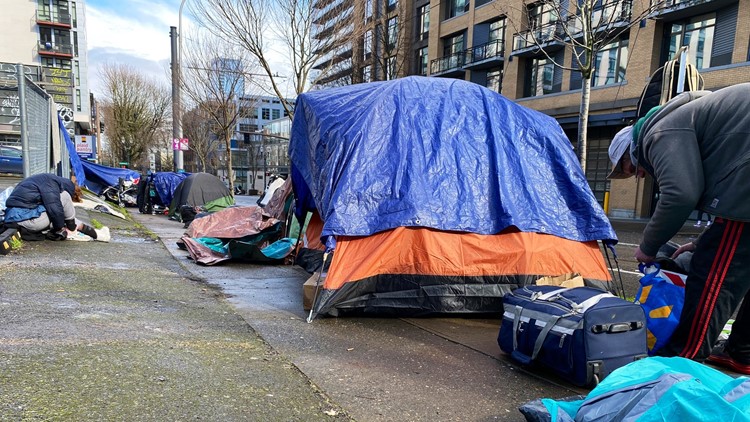PORTLAND, Ore. — Multnomah County published for the first time on Wednesday data on the number of people experiencing homelessness based on individual interactions with services instead of biennial point-in-time counts . The data reveals that nearly 15,000 people are considered homeless in some form.
The dashboard consists of data as of February 2025, drawing from a long-awaited by-name list of individuals. At that time, Multnomah County listed 14,864 people experiencing homelessness; 6,796 unsheltered, 4,860 in shelter, and 3,208 in unknown circumstances. Of those people, a total of 7,485 people were considered chronically homeless, defined as individuals who are very low-income, having one or more disabilities, and experiencing long-term homelessness or at high risk of the same.

Among that population, 3,908 were unsheltered, 2,921 were sheltered, and 656 were unknown. The data also shows that while the number of people in shelter has continued to climb within the last year, so have the numbers of people in all categories. While unsheltered homelessness plateaued for much of the last year, the total number of people considered unsheltered had still grown by nearly 2,000 people between January 2024 and February of this year.
RELATED: Sheltered homelessness increased 24% across Oregon by start of 2024, PSU report finds In a statement, the county noted that this newly available data provides a more accurate picture of homelessness in Multnomah County than ever before, but is also one that is "more grim" than previous estimates. The total recorded homeless population increased 26% between January 2024 and the beginning of this year. “Better data leads to more informed decisions, and we have many difficult decisions ahead in our continuing work to tackle our homelessness crisis,” said Multnomah County Chair Jessica Vega Pederson in a statement.
“This accurate and timely data is a major milestone that provides increased transparency and accountability while helping frontline workers, decision-makers, and the whole community make progress that we can more easily track and therefore achieve. The data also makes clear that our work is more important and necessary than ever." RELATED: Texts reveal friction between Multnomah County, Metro leaders over 'backroom dealing' on homelessness According to the county, the actual by-name list behind this data shows a significant amount of churn in the homeless population.
Only 48% of the people recorded in January 2024 remained on the list as of February 2025 — the remaining 52% were no longer appearing. By the beginning of this year, the county noted, about three people had joined the list for every two who either exited to housing or simply stopped showing up. However, the list depends on interactions with services, which does not necessarily mean these "inactive" individuals are gone from the county or are no longer homeless.
The data also does not necessarily reflect the growth in homelessness so much as the rise in these interactions, stressed Anna Plumb, deputy director of the county's Homeless Services Department. “It might seem counterintuitive, but increased services can actually lead to a higher count of people experiencing homelessness,” said Plumb. “That’s because we are actually reaching more people than ever before — and making sure they are captured in our data.
” RELATED: Southeast Portland nonprofit worried about potential Multnomah County cuts to homeless program funding Regardless, the data suggests that homelessness as a whole in Multnomah County is growing more quickly than options for shelter and exits to housing, as there are no trends in the data of note that point toward a sustained turnaround. "Our region has a new baseline from which to anchor strategy and performance. We are saddened, but not surprised by this data,” said Dr.
Andrew B. Mendenhall, president and CEO of Central City Concern. “The impact of the wave of individuals impacted by fentanyl and methamphetamine use disorders and untreated severe mental illness combined with a chronically inadequate affordable housing supply are driving the imbalance between inflows and outflows to homelessness within our region.
"Eviction prevention and housing placements are making a difference, but we must continue to scale behavioral health treatment access and affordable housing development with purpose and haste.” Multnomah County's data shows that the vast majority of people recorded as becoming homeless each month are still new to that status — at least within the county — compared to those returning from permanent housing or those who otherwise disappeared from the system for a prolonged period of time, usually between 90 and 180 days at least. The by-name list of service interactions that makes up the source for this data has been years in the making, and was a major point of criticism from former county commissioner Sharon Meieran, who claimed that the county was not prioritizing its creation.
The county first embraced Built for Zero , a nationwide initiative to address homelessness through this kind of real-time data, back in 2021. But as of May 2023 , the county's list had only been able to encapsulate some 2,800 people who were considered chronically homeless. In that sense, the rollout of Multnomah County's dashboard does represent a major milestone, one that required years of effort, conflict and cajoling to complete.
This is a developing story and may be updated with more details as they emerge..
Politics

Data from Multnomah County's long-awaited by-name list reveals 15K people experiencing homelessness

The county dashboard includes those who are sheltered and some in unknown circumstances, but nearly 6,800 people were listed as unsheltered as of February.















